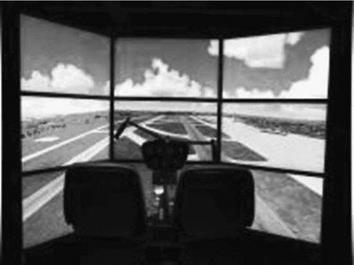The main difference between the plasma technology and other display systems is the way that a source of light is produced in each pixel (point in the projected image). In between the flat glass panels, loaded electrodes create tiny explosions of xenon gas, which lead to an ultraviolet light radiation. This radiation creates red, green,
|
FIGURE 4.34 Simulation control room for helicopter training. (See colour insert.) |
and blue phosphorus light at the back of the screen. The plasma picture is extremely clear with very high sharpness of image, which extends evenly into every corner of the screen, all without any distortion or flickering. Further advantages of this technology are a narrow depth as well as insensitivity to magnetic influences. A major disadvantage is that during a continuous 24 hours of operation there is a tendency for pictures to ‘burn-in’. This effect is irreversible and leads to a lasting reduction in the quality of the plasma screen display.
The technology is suitable for home cinema, shopping malls (for use with video), and trade shows. Advantages are the wide availability and a relatively low price. Disadvantages include the propensity to burn in images during prolonged periods of continuous use, an image format of 16:9 against the prevailing industrial standard of 4:3 or 5:4, and large gaps in between the displays when these are put together.




